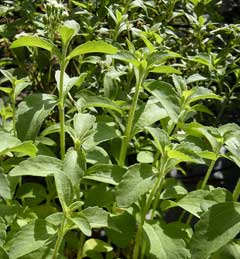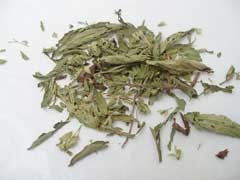 |
|
|
 |
| http://commons.wikimedia.org/wiki/User:Man77 |
Translate this page:
Summary
Physical Characteristics

 Stevia rebaudiana is a ANNUAL growing to 0.5 m (1ft 8in).
Stevia rebaudiana is a ANNUAL growing to 0.5 m (1ft 8in).
See above for USDA hardiness. It is hardy to UK zone 9 and is frost tender. The species is hermaphrodite (has both male and female organs) and is pollinated by Insects.
Suitable for: light (sandy) and medium (loamy) soils. Suitable pH: mildly acid, neutral and basic (mildly alkaline) soils. It cannot grow in the shade. It prefers moist soil.
UK Hardiness Map
US Hardiness Map
Synonyms
Eupatorium rebaudianum.
Plant Habitats
Cultivated Beds; South Wall. By. West Wall. By.
Edible Uses
Edible Parts: Leaves
Edible Uses: Sweetener
Leaves - raw or cooked. A very sweet liquorice-like flavour[K]. The leaves contain 'stevioside', a substance that is 300 times sweeter than sucrose[183]. Other reports say that they contain 'estevin' a substance that, weight for weight, is 150 times sweeter than sugar[4, 46, 61, 105]. The dried leaves can be ground and used as a sweetener or soaked in water and the liquid used in making preserves[183]. The powdered leaves are also added to herb teas[183]. The leaves are sometimes chewed by those wishing to reduce their sugar intake[183]. The leaves can also be cooked and eaten as a vegetable[105, 177].
References More on Edible Uses
Medicinal Uses
Plants For A Future can not take any responsibility for any adverse effects from the use of plants. Always seek advice from a professional before using a plant medicinally.
Hypoglycaemic
None known
References More on Medicinal Uses
The Bookshop: Edible Plant Books
Our Latest books on Perennial Plants For Food Forests and Permaculture Gardens in paperback or digital formats.

Edible Tropical Plants
Food Forest Plants for Hotter Conditions: 250+ Plants For Tropical Food Forests & Permaculture Gardens.
More

Edible Temperate Plants
Plants for Your Food Forest: 500 Plants for Temperate Food Forests & Permaculture Gardens.
More

More Books
PFAF have eight books available in paperback and digital formats. Browse the shop for more information.
Shop Now
Other Uses
References More on Other Uses
Cultivation details
Prefers a sandy soil, requiring a warm sunny position[200]. It is a short day plant, growing up to 0.6 meters in the wild and flowering from January to March in the southern hemisphere. Flowering under short day conditions should occur 54-104 days following transplanting, depending on the daylength sensitivity of the cultivar. The natural climate is semi-humid subtropical with temperature extremes from 21 to 43 C, averaging 24 C. Stevia grows in areas with up to 1375mm of rain a year. Plants are not very frost resistant, but can be grown as half-hardy annuals in Britain, starting them off in a greenhouse and planting them out after the last expected frosts.
References Carbon Farming Information and Carbon Sequestration Information
Temperature Converter
Type a value in the Celsius field to convert the value to Fahrenheit:
Fahrenheit:
The PFAF Bookshop
Plants For A Future have a number of books available in paperback and digital form. Book titles include Edible Plants, Edible Perennials, Edible Trees,Edible Shrubs, Woodland Gardening, and Temperate Food Forest Plants. Our new book is Food Forest Plants For Hotter Conditions (Tropical and Sub-Tropical).
Shop Now
Plant Propagation
Seed - sow spring in a warm greenhouse and only just cover the seed. Make sure the compost does not dry out. Prick out the seedlings into individual pots and grow them on fast, planting them out after the last expected frosts. It could be worthwhile giving them some protection such as a cloche or cold frame for a few weeks after planting them out until they are growing away well.
Other Names
If available other names are mentioned here
Native Range
SOUTHERN AMERICA: Brazil (Mato Grosso do Sul, Minas Gerais), Paraguay (Amambay, Concepción)
Weed Potential
Right plant wrong place. We are currently updating this section.
Please note that a plant may be invasive in one area but may not in your area so it's worth checking.
Conservation Status
IUCN Red List of Threatened Plants Status :

Growth: S = slow M = medium F = fast. Soil: L = light (sandy) M = medium H = heavy (clay). pH: A = acid N = neutral B = basic (alkaline). Shade: F = full shade S = semi-shade N = no shade. Moisture: D = dry M = Moist We = wet Wa = water.
Now available:
Food Forest Plants for Mediterranean Conditions
350+ Perennial Plants For Mediterranean and Drier Food Forests and Permaculture Gardens.
[Paperback and eBook]
This is the third in Plants For A Future's series of plant guides for food forests tailored to
specific climate zones. Following volumes on temperate and tropical ecosystems, this book focuses
on species suited to Mediterranean conditions—regions with hot, dry summers and cool, wet winters,
often facing the added challenge of climate change.
Read More
Expert comment
Author
Bertoni.
Botanical References
200
Links / References
For a list of references used on this page please go here
Readers comment